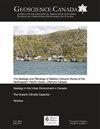Accretion, Soft and Hard Collision: Similarities, Differences and an Application from the Newfoundland Appalachian Orogen
IF 0.8
4区 地球科学
Q3 GEOSCIENCES, MULTIDISCIPLINARY
引用次数: 13
Abstract
We argue there is no distinction between accretion and collision as a process, except when accretion is used in the sense of incorporating small bodies of sedimentary and/or volcanic rocks into an accretionary wedge by off-scraping or underplating. There is also a distinction when these terms are used in classifying mountain belts into accretionary and collisional orogens, although such classifications are commonly based on a qualitative assessment of the scale and nature of the accreted terranes and continents involved in formation of mountain belts. Soft collisions occur when contractional deformation and associated metamorphism are principally concentrated in rocks of the leading edge of the partially pulled-down buoyant plate and the upper plate forearc terrane. Several young arc-continent collisions show evidence for partial or wholesale subduction of the forearc such that the arc is structurally juxtaposed directly against lower plate rocks. This process may explain the poor preservation of forearcs in the geological record. Soft collisions generally change into hard collisions over time, except if the collision is rapidly followed by formation of a new subduction zone due to step-back or polarity reversal. Thickening and metamorphism of the arc's suprastructure and retro-arc part of upper plate due to contractional deformation and burial are the characteristics of a hard collision or an advancing Andean-type margin. Strong rheological coupling of the converging plates and lower and upper crust in the down-going continental margin promotes a hard collision. Application of the soft–hard terminology supports a structural juxtaposition of the Taconic soft collision recorded in the Humber margin of western Newfoundland with a hard collision recorded in the adjacent Dashwoods block. It is postulated that Dashwoods was translated dextrally along the Cabot-Baie Verte fault system from a position to the north of Newfoundland where the Notre Dame arc collided ca. 10 m.y. earlier with a wide promontory in a hyperextended segment of the Laurentian margin.增生、软硬碰撞:纽芬兰-阿巴拉契亚造山带的异同与应用
我们认为,作为一个过程,增生和碰撞之间没有区别,除非增生是指通过刮离或底板将小块沉积岩和/或火山岩合并成增生楔。在将山带分为增生造山带和碰撞造山带时使用这些术语也有区别,尽管这种分类通常是基于对参与山带形成的增生地体和大陆的规模和性质的定性评估。当收缩变形和伴生变质作用主要集中在部分下拉浮力板块前缘和板块上部弧前地体的岩石中时,就会发生软碰撞。几次年轻的弧-大陆碰撞显示出弧前部分或整体俯冲的证据,使弧在结构上直接与较低的板块岩石并列。这一过程可以解释地质记录中前弧保存不佳的原因。随着时间的推移,软碰撞通常会转变为硬碰撞,除非碰撞之后由于后退或极性反转而迅速形成新的俯冲带。由于收缩变形和埋藏作用,弧上构造增厚变质,上板块后弧部分变厚变质,是一个硬碰撞或前进的安第斯型边缘的特征。在下行大陆边缘,汇聚板块与上下地壳的强流变耦合促进了硬碰撞。软-硬术语的应用支持了在纽芬兰西部亨伯边缘记录的Taconic软碰撞与相邻达什伍德地块记录的硬碰撞的结构并置。据推测,达什伍德是沿着卡伯特-贝维特断层系统从纽芬兰北部的一个位置右移过来的,大约10英里前,圣母院弧形与劳伦森边缘超延伸部分的一个宽海角发生了碰撞。
本文章由计算机程序翻译,如有差异,请以英文原文为准。
求助全文
约1分钟内获得全文
求助全文
来源期刊

Geoscience Canada
地学-地球科学综合
CiteScore
3.30
自引率
0.00%
发文量
9
审稿时长
>12 weeks
期刊介绍:
Established in 1974, Geoscience Canada is the main technical publication of the Geological Association of Canada (GAC). We are a quarterly journal that emphasizes diversity of material, and also the presentation of informative technical articles that can be understood not only by specialist research workers, but by non-specialists in other branches of the Earth Sciences. We aim to be a journal that you want to read, and which will leave you better informed, rather than more confused.
 求助内容:
求助内容: 应助结果提醒方式:
应助结果提醒方式:


